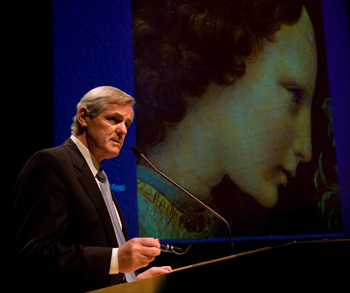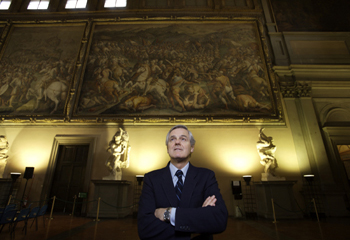In Search of History: UC San Diego Merges Art and Science to Decode the Hidden History of Works of Art, Architecture and Archaeology
San Diego, CA, March 1, 2007 -- The University of California, San Diego is moving into a novel area of research for a university: diagnostic imaging and analytical testing of paintings, sculptures, buildings, as well as archaeological sites and artifacts. It has also lured a pioneer of the field from Florence to run the new center and several high-profile projects that are already underway.
|
The campus announced today the creation of the Center of Interdisciplinary Science for Art, Architecture and Archaeology (CISA3), and the appointment of 'art diagnostician' Maurizio Seracini as its founding director.
"Science can bring so much to our understanding and appreciation of art," said Seracini, "and we are creating a new discipline where art and engineering go hand in hand."
CISA3 will pursue field projects around the world, while tapping the expertise of scientists and engineers at UC San Diego to develop new tools and techniques to search for clues to the true history of great works of art.
Center officials foresee training a new generation of interdisciplinary experts to work in this emerging field, and a partnership with the San Diego Museum of Art will give UCSD students hands-on experience in San Diego.
|
The new center is part of the California Institute for Telecommunications and Information Technology (Calit2) on the UC San Diego campus. It is a collaboration with the university's Division of Arts & Humanities and the Jacobs School of Engineering.
"CISA3 can play a leadership role in the use and development of technologies to reconstruct and analyze the history of great works art as well as their state of conservation," said Calit2 division director Ramesh Rao, who is also a professor of electrical and computer engineering in the Jacobs School. "Maurizio could have gone elsewhere, but he chose UCSD because of Calit2's impressive track record in technology development, as well as its interdisciplinary ethos.""The Annunciation"
At today's press conference, the new center announced three inaugural projects. In January, CISA3 dispatched a team to Florence, where they scanned Leonardo Da Vinci's "The Annunciation" at various wavelengths of light, to assess its state of conservation and uncover the artist's initial sketches beneath the paint. Initial results will be published this spring, before the painting is temporarily moved from the Uffizi to a museum in Japan as part of a Da Vinci exhibition.
Unlike many of Da Vinci's paintings, which he left unfinished, the artist is believed to have painted "The Annunciation" from start to finish. Seracini first studied the painting in 1989, before some of today's most advanced diagnostic imaging technologies became available.
Palazzo Medici
UCSD officials also today signed a Memorandum of Understanding with the Province of Florence to study the Palazzo Medici - one of the most important structures of the Renaissance. The building in Florence became the prototype of Renaissance civil architecture and a symbol of the Medici family's primacy in Florence. It has belonged to the Province since 1874, which hopes to learn more about its history by opening the Palazzo Medici to researchers from UC San Diego.
|
"We are particularly excited about this project because the Palazzo Medici will be a case study for understanding how structures evolve and survive over hundreds of years," said Frieder Seible, a structural engineer and Dean of UCSD's Jacobs School of Engineering. "We also hope to contribute our expertise in seismic retrofit technologies that could be useful in efforts to preserve such structures."
Murals, frescoes, artifacts and even hidden passageways are presumed to have disappeared after successive remodelings of the Palazzo Medici dating back more than 500 years. Using existing and still-to-be-developed technologies that will allow them to "see" inside walls, CISA3 researchers hope to rediscover how the structure itself has evolved since it was built in the mid-15th century. The results will be made available to the public in the form of interactive, 3D multimedia exhibits and television documentaries.
Digital Clinical Charts
Since the mid-1980s, CISA3 director Seracini has advocated for a new approach to conservation of artwork in museums and private collections: the "digital clinical chart." The concept is based on medical charts, and would involve a complete battery of tests to gauge the "health" of the artwork. Now, in conjunction with the San Diego Museum of Art, CISA3 has decided to embark on a pilot project to demonstrate the value of clinical charts as a baseline for future efforts at restoration, preservation and conservation of individual artworks.
In spring 2007, CISA3 will begin studies of half a dozen major works in the San Diego museum's permanent collection, including Giorgione's "Portrait of a Young Man", Juan Sánchez Cotán's "Quince, Cabbage, Melon and Cucumber", and Bernardino Luini's "The Conversion of the Magdalene".
|
Maurizio Seracini
The center builds on the 30-year career of its director. Maurizio Seracini has studied more than 2,500 of the world's most important paintings, frescoes, statues and historical buildings.
|
Seracini is a pioneer in the use of multispectral imaging and other diagnostic as well as analytical technologies as applied to works of art and structures. He joined Calit2 at UC San Diego in 2006, more than thirty years after graduating from UCSD with a B.A. in bioengineering in 1973. Seracini returned to Italy for graduate school and received the Laurea degree in electronic engineering from the University of Padua, where he went on to study medicine. From 1975-77, he participated in the "Leonardo Project," to locate the long-lost fresco, "The Battle of Anghiari" (a project sponsored by the Armand Hammer Foundation, Kress Foundation and Smithsonian Institute). In 1977, Seracini established Editech, a Florence-based company that was the first to provide art and architectural diagnostic services.
Related Links
CISA3
Media Contacts
Media Contact: Doug Ramsey, 858-822-5825, dramsey@ucsd.edu






